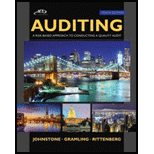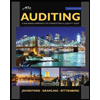
a.
Concept Introduction:
Decision Making−It is the process of making a choice by identifying the decision, collecting relevant information and choosing possible alternatives.
The auditors were to be held responsible for fraud and gross negligence, though not for negligence.
To discuss:If owning stock in client’s firm is inappropriate.
b.
Concept Introduction:
Decision Making−It is the process of making choice by identifying the decision, collecting relevant information and choosing possible alternatives.
The auditors were to be held responsible for fraud and gross negligence, though not for negligence.
To comment: About the auditors being independent.
c.
Concept Introduction:
Decision Making−It is the process of making choice by identifying the decision, collecting relevant information and choosing possible alternatives.
The auditors were to be held responsible for fraud and gross negligence, though not for negligence.
To comment: About the action taken by the company on auditor.
d.
Concept Introduction:
Decision Making−It is the process of making choice by identifying the decision, collecting relevant information and choosing possible alternatives.
The auditors were to be held responsible for fraud and gross negligence, though not for negligence.
To comment: About the unprofessional decision made by the auditor.
e.
Concept Introduction:
Decision Making−It is the process of making choice by identifying the decision, collecting relevant information and choosing possible alternatives.
The auditors were to be held responsible for fraud and gross negligence, though not for negligence.
To State: The services procedures for protecting the career of the tipster.
Want to see the full answer?
Check out a sample textbook solution
Chapter 4 Solutions
Auditing: A Risk Based-Approach to Conducting a Quality Audit
- explain properly all the answer for General accounting question Please given fastarrow_forwardPlease help me solve this financial accounting problem with the correct financial process.arrow_forwardPlease explain the solution to this general accounting problem using the correct accounting principles.arrow_forward
- The Cambridge Manufacturing's next expected dividend, D1, is $2.85; its growth rate is 6.2 percent, and its stock currently sells for $46.30. New stock can be sold to net the firm $43.05 per share. a. What is Cambridge's percentage flotation cost? b. What is Cambridge's cost of new common stock? Provide answerarrow_forwardCan you explain the process for solving this financial accounting question accurately?arrow_forwardIf Sierra Manufacturing had their total liabilities increased by $8,400 and stockholders' equity decreased by $3,700 during a period of time. Then total assets must have changed by what amount and direction during that same period? Helparrow_forward
- Please explain the solution to this general accounting problem with accurate principles.arrow_forwardQuaker Industries has a cost of goods manufactured of $550,000, beginning finished goods inventory of $150,000, and ending finished goods inventory of $200,000. The cost of goods sold is: A. $400,000 B. $500,000 C. $550,000 D. $600,000arrow_forwardA change in accounting estimate is applied? (A) Retrospectively (B) Neither prospectively nor retrospectively (C) Both prospectively and retrospectively (D) Prospectively solve thisarrow_forward
 Auditing: A Risk Based-Approach to Conducting a Q...AccountingISBN:9781305080577Author:Karla M Johnstone, Audrey A. Gramling, Larry E. RittenbergPublisher:South-Western College Pub
Auditing: A Risk Based-Approach to Conducting a Q...AccountingISBN:9781305080577Author:Karla M Johnstone, Audrey A. Gramling, Larry E. RittenbergPublisher:South-Western College Pub Auditing: A Risk Based-Approach (MindTap Course L...AccountingISBN:9781337619455Author:Karla M Johnstone, Audrey A. Gramling, Larry E. RittenbergPublisher:Cengage Learning
Auditing: A Risk Based-Approach (MindTap Course L...AccountingISBN:9781337619455Author:Karla M Johnstone, Audrey A. Gramling, Larry E. RittenbergPublisher:Cengage Learning Survey of Accounting (Accounting I)AccountingISBN:9781305961883Author:Carl WarrenPublisher:Cengage Learning
Survey of Accounting (Accounting I)AccountingISBN:9781305961883Author:Carl WarrenPublisher:Cengage Learning- Business/Professional Ethics Directors/Executives...AccountingISBN:9781337485913Author:BROOKSPublisher:Cengage



